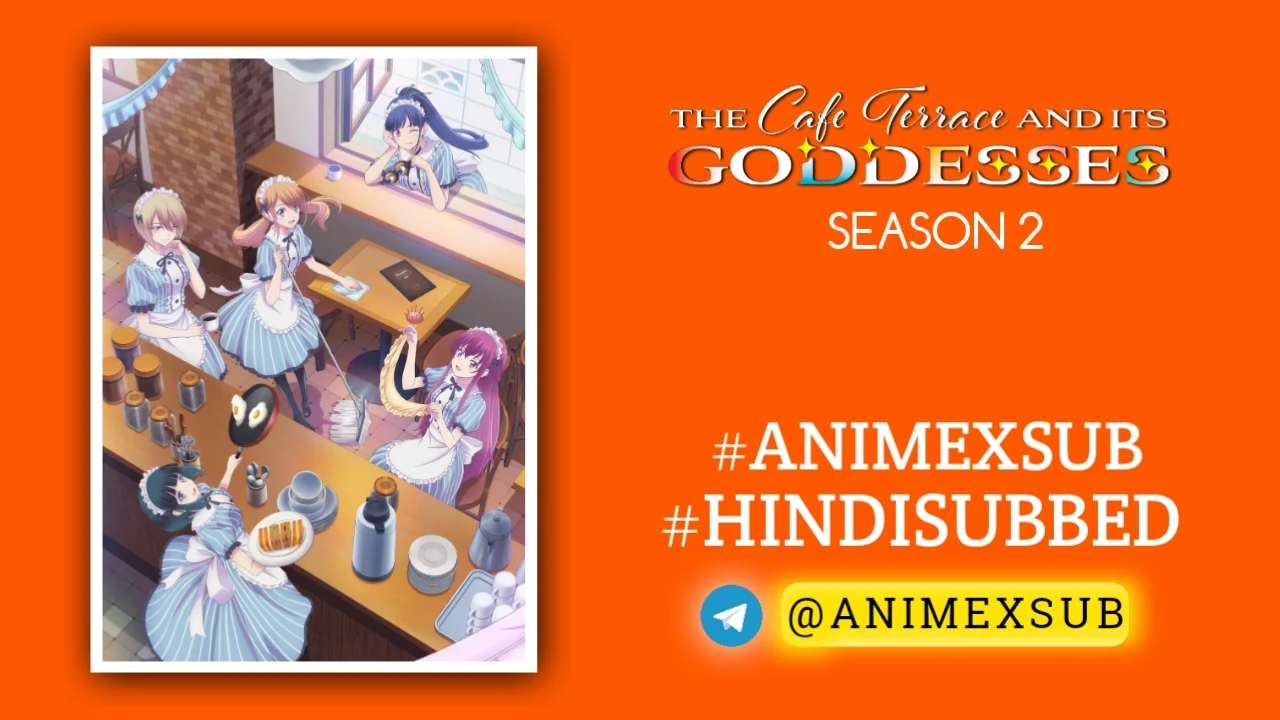
Cultural Exchange With a Game Centre Girl Hindi Subbed [06/12] | Game Center Shoujo to Ibunka Kouryuu Hindi Sub!!

GaCen Shoujo to Ibunka Kouryuu
Cultural Exchange with a Game Centre GirlSynopsis
Kusakabe Renji, a young man working at a game centre, sees an English girl named Lily Baker playing a crane game on Valentine’s Day. Seeing her fail repeatedly to win a prize, Renji can’t help but take action. The day after Lily finally gets her plushie, Renji receives an unexpected message from her that reads, “Be my valentine!” What started as a misunderstanding leads to cultural exchange! (Source: Crunchyroll)
Watch Trailer
Characters
Cultural Exchange with a Game Centre Girl Season 1: A Refreshing Take on Cross-Cultural Connection
Cultural Exchange with a Game Centre Girl (Japanese: Gēsen Shōjo to Ibunka Kōryū), a 2025 anime adaptation of Hirokazu Yasuhara’s manga, is a delightful and nuanced exploration of cross-cultural friendship, wrapped in a vibrant arcade setting. Season 1, spanning 12 episodes, aired from July 6, 2025, and quickly carved a niche for itself in the crowded Summer 2025 anime lineup. This series stands out not for flashy spectacle but for its understated sincerity, clever handling of cultural nuances, and a commitment to authentic character-driven storytelling. Below is a detailed, spoiler-light review of what makes this anime a unique and compelling watch, diving into its narrative, characters, themes, animation, and sound design, while offering fresh insights into its understated brilliance.
Narrative: A Subtle Blend of Heart and Humor
At its core, Cultural Exchange with a Game Centre Girl is a slice-of-life romantic comedy that thrives on simplicity and authenticity. The story follows Renji Kusakabe, an 18-year-old university student and part-time arcade employee, who crosses paths with Lily Baker, a 13-year-old British girl new to Japan. Their story begins with a chance encounter on Valentine’s Day, where a misunderstanding—sparked by Renji’s kind gesture of winning a “Manly Koala” plushie for Lily—sets the stage for a heartwarming tale of friendship and cultural discovery. The premise is deceptively straightforward: a language barrier, a cultural mix-up, and a shared love for arcade games form the foundation of their evolving bond.
What sets the narrative apart is its refusal to lean into overused anime tropes. Instead of escalating into melodramatic romance or exaggerated comedy, the series focuses on the quiet moments of connection between Renji and Lily. Their relationship is not about grand gestures but about small, meaningful exchanges—shared diaries, halting conversations in broken English and Japanese, and mutual efforts to understand each other’s worlds. The show’s pacing is deliberate, allowing character interactions to breathe, which makes every smile, awkward pause, or shared laugh feel earned. While some might find the lack of high-stakes drama underwhelming, it’s precisely this restraint that makes the series feel grounded and relatable.
The narrative also cleverly integrates the arcade setting as more than just a backdrop. It’s a microcosm of playfulness and challenge, mirroring the characters’ attempts to navigate their cultural differences. Episodes often weave in light commentary on gaming culture, from the frustration of rigged crane games to the absurdity of poorly designed VR experiences, adding a layer of humor that resonates with anyone who’s spent time in an arcade. Yet, the show never loses sight of its emotional core: the joy of learning about another person’s perspective, even when words fail.
Characters: Authentic and Endearing
The strength of Cultural Exchange lies in its characters, who feel like real people rather than archetypes. Renji Kusakabe, voiced by Shōya Chiba, is a refreshing protagonist—kind, mature, and self-aware without being bland. His decision to gently rebuff Lily’s initial romantic interest due to their age gap (a five-year difference that the show handles with surprising sensitivity) showcases his emotional intelligence. Renji’s attempts to communicate with Lily through broken English and shared interests, like arcade games, make him a relatable figure for anyone who’s ever fumbled through a cross-cultural interaction.
Lily Baker, voiced by Sally Amaki, is the heart of the series. Her British accent and limited Japanese proficiency are portrayed with authenticity, avoiding the caricature often seen in anime depictions of foreigners. Lily’s personality—shy yet passionate, especially about arcade games and koala-themed merchandise—strikes a balance between “moe” charm and genuine individuality. Amaki’s performance, particularly in scenes where Lily speaks entirely in English with Japanese subtitles, adds a layer of realism that elevates the show’s cultural exchange theme. Her determination to connect with Renji, despite linguistic and cultural barriers, is both endearing and inspiring.
Supporting characters, like Renji’s younger sister Aoi (voiced by Reo Osanai), add depth to the story. Aoi, who becomes Lily’s classmate and friend, serves as a bridge between the two leads, offering both comedic relief and emotional support. Other characters, such as arcade regulars Karin, Hotaru, and Momoko, bring additional flavor to the ensemble, though their roles are less developed in Season 1. The show’s focus remains firmly on Renji and Lily, with supporting characters enhancing rather than overshadowing their dynamic.
Themes: A Nuanced Look at Connection
Thematically, Cultural Exchange excels in its exploration of cross-cultural communication without resorting to stereotypes or heavy-handed moralizing. The series captures the awkwardness, humor, and beauty of two people from different worlds trying to understand each other. It doesn’t shy away from the challenges—misunderstandings due to language barriers, differing cultural norms around gestures like Valentine’s Day gifts—but it presents them with a light touch, emphasizing mutual respect and curiosity.
One of the show’s most compelling aspects is its portrayal of the language barrier. Unlike many anime where foreign characters inexplicably speak fluent Japanese, Lily’s limited Japanese and Renji’s halting English create a realistic dynamic. Their use of a shared diary to communicate—writing notes and drawings to bridge the gap—feels innovative and deeply personal. This device not only drives the plot but also serves as a metaphor for the effort required to build meaningful connections across cultures.
The series also subtly addresses the age gap between Renji and Lily, a potential point of contention for some viewers. Rather than ignoring it, the show tackles it head-on, with Renji setting clear boundaries while maintaining a supportive friendship. This mature handling of a sensitive topic adds depth to the narrative and sets it apart from less thoughtful rom-coms.
Animation and Sound: Vibrant and Functional
Visually, the series, produced by Studio Nomad, is solid but not groundbreaking. The animation is colorful and expressive, with the arcade setting brought to life through bright neon lights, detailed game machines, and a nostalgic aesthetic that evokes classic Japanese game centers. Character designs are soft and approachable, reminiscent of other slice-of-life anime like Onimai or Kiniro Mosaic, but with a distinct charm. The show’s use of visual gags, like Lily’s exaggerated expressions when she fails at a crane game, adds to the comedic appeal without overwhelming the story.
The sound design is a standout, particularly in the voice acting. Sally Amaki’s performance as Lily is a highlight, her natural English delivery and British accent lending authenticity to the character. Shōya Chiba’s Renji complements her perfectly, his broken English both funny and relatable. The background music, composed by Takurō Iga, is serviceable but unremarkable, with the opening theme “Their Start Button” (performed by Amaki and Osanai) and ending theme “Amusing Flavor” (by Amaki) capturing the show’s playful tone but lacking the memorability of iconic anime songs. Sound effects, from the clinks of coins to the whirs of arcade machines, enhance the immersive quality of the setting.
Unique Strengths and Critiques
What makes Cultural Exchange with a Game Centre Girl stand out is its commitment to authenticity and restraint. The show avoids the pitfalls of over-the-top “Engrish” humor or exotifying its foreign character, instead offering a nuanced portrayal of cultural exchange. The arcade setting, while niche, is a clever vehicle for the story, providing a universal space where people from different backgrounds can connect through shared experiences. The series also deserves praise for its handling of the age gap, addressing it maturely without letting it dominate the narrative.
However, the show isn’t flawless. The pacing can feel slow for viewers accustomed to more action-packed or emotionally intense anime. Some supporting characters, like Karin and Hotaru, feel underutilized, with their arcs hinted at but not fully explored in Season 1. The music, while pleasant, lacks the spark to make it memorable, and the animation, while competent, doesn’t push boundaries. Additionally, the show’s reliance on the language barrier for humor might not resonate with all viewers, as comedy is subjective.
Why It’s Worth Watching
Cultural Exchange with a Game Centre Girl Season 1 is a gem for fans of slice-of-life and romantic comedy anime, offering a fresh take on cross-cultural connection. Its strength lies in its sincerity, authentic character interactions, and clever use of the arcade setting to explore themes of communication and friendship. While it may not appeal to those seeking high-stakes drama or flashy visuals, it’s a perfect watch for anyone craving a light, heartwarming story that celebrates the small moments that make relationships meaningful.
For viewers who enjoyed Kiniro Mosaic or Horimiya, this series offers a similar blend of humor and heart, but with a unique focus on linguistic and cultural barriers. It’s a reminder that connection doesn’t require perfection—just patience, kindness, and a willingness to press the “start button” together.
Rating: 8/10
Previous Standout Episodes: Episode 1 (“Boy Meets the Game Centre Girl”), Episode 3 (“Where Is Your Brother?”), Episode 5 (“This Is My Dad!”)
Where to Watch: Crunchyroll, AT-X, Tokyo MX, and other platforms
Note: This anime is a testament to the power of simple storytelling done right, proving that even in a crowded season, a quiet tale of friendship can leave a lasting impression.
Support Our Anime Community!
Love watching the latest anime? Help us keep uploading new episodes by join telegram channel ❤️
Join Now!








